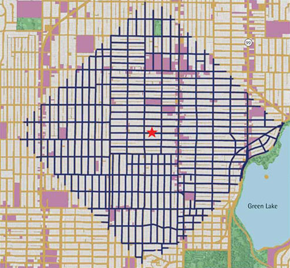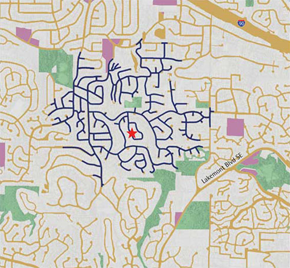I checked out other houses I've lived in and one was 45 and another was 66. Those are still considered not very walkable neighborhoods. So what's the criteria? Here's a bit from their site,
Walkable Neighborhoods
Picture a walkable neighborhood. You lose weight each time you walk to the grocery store. You stumble home from last call without waiting for a cab. You spend less money on your car—or you don't own a car. When you shop, you support your local economy. You talk to your neighbors.
What makes a neighborhood walkable?
Walkable communities tend to have the following characteristics:
- A center: Walkable neighborhoods have a discernable center, whether it's a shopping district, a main street, or a public space.
- Density: The neighborhood is dense enough for local businesses to flourish and for public transportation to be cost effective.
- Mixed income, mixed use: Housing is provided for everyone who works in the neighborhood: young and old, singles and families, rich and poor. Businesses and residences are located near each other.
- Parks and public space: There are plenty of public places to gather and play.
- Accessibility: The neighborhood is accessible to everyone and has wheelchair access, plenty of benches with shade, sidewalks on all streets, etc.
- Well connected, speed controlled streets: Streets form a connected grid that improves traffic by providing many routes to any destination. Streets are narrow to control speed, and shaded by trees to protect pedestrians.
- Pedestrian-centric design: Buildings are placed close to the street to cater to foot traffic, with parking lots relegated to the side or back.
- Close schools and workplaces: Schools and workplaces are close enough that most residents can walk from their homes.
Information compiled from CoolTown Studios and Walkable Communities, Inc.
One-Mile Walk in a Compact Neighborhood

A one-mile walk in Seattle's Phinney Ridge, takes you through a grid like street network with a mix of residences and businesses (shown in purple). Map courtesy of the Sightline Institute.
One-Mile Walk in a Sprawling Suburb

A one-mile walk in Bellevue, WA with cul-de-sacs and winding streets has few shops and services within walking distance. Map courtesy of the Sightline Institute.
Here's the scoring:
What does my score mean?
Your Walk Score is a number between 0 and 100. The walkability of an address depends on how far you are comfortable walking—after all, everything is within walking distance if you have the time. Here are general guidelines for interpreting your score:
- 90 - 100 = Walkers' Paradise: Most errands can be accomplished on foot and many people get by without owning a car.
- 70 - 90 = Very Walkable: It's possible to get by without owning a car.
- 50 - 70 = Some Walkable Locations: Some stores and amenities are within walking distance, but many everyday trips still require a bike, public transportation, or car.
- 25 - 50 = Not Walkable: Only a few destinations are within easy walking range. For most errands, driving or public transportation is a must.
- 0 - 25 = Driving Only: Virtually no neighborhood destinations within walking range. You can walk from your house to your car!
Darn these unnatural suburbs! They are completely car dependent--thanks 50s mentality. How's that going to work when gas costs $10 a gallon. (Does anyone think it won't get that high? Where's the freak out now that it's $4 a gallon? You know how to boil a frog, right?) You can't just pack up the ol' station wagon and load up the kids with fluffernutter sandwiches and go for a spin when it will cost all of the college savings to go across town.
Good thing my husband is into bikes as vehicles, not just as a means to exercise or a way to get some alone time. No. It's about getting around this town without depending on gas. I have a trickier time of it with the kids, because my daughter isn't that great at longer distances. She's a nervous rider. She and I will have to ride the tandem, and my son can ride his bike.
We've got to get off this gas dependency, and since our neighborhood isn't very walkable, we'll have to learn to ride more. What's your Walk Score? Do you have a bike...





8 comments:
Our walk score is 78. We deliberately decided not to live in the 'burbs so that we could walk or bike most places. DH can walk to work in 7min. How cool is that?
That's fantastic! I wish we were more conscious of things like this way back when we bought our house 10 years ago. We just weren't thinking about this then.
At least my husband's bike commute is about 20 mins. Completely doable and a nice way to start and end his work day.
My walk score is 62. I agree with that assessment. Fortunately we're only two blocks from a couple of bus stops for routes that will take us to a lot of our primary destinations. Plus 4 blocks to the bus station for all the other routes. AND we have a snazzy bike trailer that our little one loves, which makes slightly-further errands not so bad.
Very cool site. Our walk score is 83. Walkability was a major factor for us when we moved here 4 years ago. We came from an isolated development in a suburb that was just boring to walk. Although the library was very close, you couldn't get there easily because of a busy road with no sidewalks. Ditto the grocery store and a few restaurants.
We used to walk around town a lot more. When we first moved here I'd walk to the post office with a stroller and a 5-year-old in hand; it probably took about a half hour. I don't ever consider doing that now. I will have to reconsider! I should be walking more.
ebehm, you know where I live. I would love to be able to walk places, but the roads are too busy--I don't want to walk there.
It really is too bad.
I'll go walk with you sometime in your neighborhood--we can run errands together!
You do have one thing going for you in your neighborhood -- it is a fairly interesting residential neighborhood. When we were in our townhouse further north, going for walks was so boring because all of the houses looked alike. There was really nothing interesting at all.
For me, it seems that the impediment to walking to do errands is time. I will walk to the library (about 5 minutes, if that) but rarely to the bank (about 10 minutes.) It's not that it *really* takes so long, just that I am thinking ahead to everything I need to do and I don't bother. I will do this more now that I am thinking about it.
Also, when I was pregnant and working, I bought a small foldable wheelie cart to lug around my computer. It has been very handy for trips to the library. The right tools make a difference.
Wow, my husband just looked up our old place and it had a walk score of 35. How much lower can you go? I suppose if you were isolated on a farm somewhere...
Post a Comment